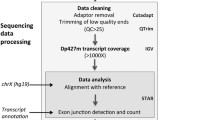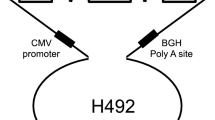Abstract
Mutations in the chloride channel gene CLCN1 cause the allelic disorders Thomsen (dominant) and Becker (recessive) myotonia congenita (MC). The encoded protein, ClC-1, is the primary channel that mediates chloride (Cl−) conductance in skeletal muscle. Mutations in CLCN1 lower the channel’s threshold voltage, leading to spontaneous action potentials that are not coupled to neuromuscular transmission and resulting in myotonia. Over 120 mutations in CLCN1 have been described, 10 % of which are splicing defects. Biological specimens suitable for RNA extraction are not always available, but obtaining genomic DNA for analysis is easy and non-invasive. This is the first study to evaluate the pathogenic potential of novel splicing mutations using the minigene approach, which is based on genomic DNA analysis. Splicing mutations accounted for 23 % of all pathogenic variants in our cohort of MC patients. Four were heterozygous mutations in four unrelated individuals, belonging to this cohort: c.563G>T in exon 5; c.1169-5T>G in intron 10; c.1251+1G>A in intron 11, and c.1931-2A>G in intron 16. These variants were expressed in HEK 293 cells, and aberrant splicing was verified by in vitro transcription and sequencing of the cDNA. Our findings confirm the need to further investigate the nature of rearrangements associated with this class of mutations and their effects on mature transcripts. In particular, splicing mutations predicted to generate in-frame transcripts may generate out-of-frame mRNA transcripts that do not produce functional ClC-1. Clinically, incomplete molecular evaluation could lead to delayed or faulty diagnosis.





Similar content being viewed by others
References
Koch MC, Steinmeyer K, Lorenz C, Ricker K, Wolf F, Otto M, Zoll B, Lehmann-Horn F, Grzeschik KH, Jentsch TJ (1992) The skeletal muscle chloride channel in dominant and recessive human myotonia. Science 257:797–800
Pusch M (2002) Myotonia caused by mutations in the muscle chloride channel gene CLCN1. Hum Mutat 19:423–434
Duno M, Colding-Jørgensen E (2008) Myotonia congenita. Gene Rev 8:1–15
Trivedi JR, Bundy B, Statland J, Salajegheh M, Rayan DR, Venance SL, Wang Y, Fialho V, Matthews E, Cleland J, Gorham N, Herbelin L, Cannon S, Amato A, Griggs RC, Hanna MG, Barohn RJ, The CINCH Consortium (2013) Non-dystrophic myotonia: prospective study of objective and patient reported outcomes. Brain 136:2198–2200
Fialho D, Kullmann DM, Hanna MG, Schorge S (2008) Non-genomic effects of sex hormones on ClC-1 may contribute to gender differences in myotonia congenita. Neuromuscul Disord 18:869–872
Burge JA, Hanna MG, Schorge S (2013) Nongenomic actions of progesterone and 17β-estradiol on the chloride conductance of skeletal muscle. Muscle Nerve 48:589–591
Matthews E, Fialho D, Tan SV, Venance SL, Cannon SC, Sternberg D, Fontaine B, Amato AA, Barohn RJ, Griggs RC, Hanna MG, CINCH Investigators (2010) The non-dystrophic myotonias: molecular pathogenesis, diagnosis and treatment. Brain 133:9–22
Ulzi G, Lecchi M, Sansone V, Redaelli E, Corti E, Saccomanno D, Pagliarani S, Corti S, Magri F, Raimondi M, D’Angelo G, Modoni A, Bresolin N, Meola G, Wanke E, Comi GP, Lucchiari S (2012) Myotonia congenita: novel mutations in CLCN1 gene and functional characterizations in Italian patients. J Neurol Sci 318:65–71
Brugnoni R, Kapetis D, Imbrici P, Pessia M, Canioni E, Colleoni L, Kerlero de Rosbo N, Morandi L, Cudia P, Gashemi N, Bernasconi P, Desaphy J-F, Conte D, Mantegazza R (2013) A large color ao myotonia congenita probands: novel mutations and high-frequency mutation region in exon 4 and 5 of the CLCN1 gene. J Hum Gen 58:581–587
Fahlke C, Desai RR, Gillani N, George AL Jr (2001) Residues lining the inner pore vestibule of human muscle chloride channels. J Biol Chem 276:1759–1765
George AL Jr, Sloan-Brown K, Fenichel GM, Mitchell GA, Spiegel R, Pascuzzi RM (1994) Nonsense and missense mutations of the muscle chloride channel gene in patients with myotonia congenita. Hum Mol Genet 3:2071–2072
Meyer-Kleine C, Steinmeyer K, Ricker K, Jentsch TJ, Koch MC (1995) Spectrum of mutations in the major human skeletal muscle chloride channel gene (CLCN1) leading to myotonia. Am J Hum Genet 57:1325–1334
Dunø M, Colding-Jørgensen E, Grunnet M, Jespersen T, Vissing J, Schwartz M (2004) Difference in allelic expression of the CLCN1 gene and the possible influence on the myotonia congenita phenotype. Eur J Hum Genet 12:738–743
Colding-Jørgensen E (2005) Phenotypic variability in myotonia congenita. Muscle Nerve 32:19–34
Richardson RC, Tarleton JC, Bird TD, Gospe SM Jr (2013) Truncating CLCN1 mutations in myotonia congenita: variable patterns of inheritance. Muscle Nerve. Epub ahead of print
Zhang J, Bendahhou S, Sanguinetti MC, Ptàček LJ (2000) Functional consequences of chloride channel gene (CLCN1) mutations causing myotonia congenital. Neurology 54:937–942
Chen L, Schaerer M, Lu ZH, Lang D, Joncourt F, Weis J, Fritschi J, Kappeler L, Gallati S, Sigel E, Burgunder JM (2004) Exon 17 skipping in CLCN1 leads to recessive myotonia congenita. Muscle Nerve 29:670–676
Licatalosi DD, Darnell RB (2006) Splicing regulation in neurologic disease. Neuron 52:93–101
Singh RK, Cooper TA (2012) Pre-mRNA splicing in disease and therapeutics. Trends Mol Med 18:472–482
Karam R, Wengrod J, Gardner LB, Wilkinson MF (2013) Regulation of nonsense-mediated mRNA decay: implications for physiology and disease. Biochim Biophys Acta 1829:624–633
Feng D, Xie J (2013) Aberrant splicing in neurological diseases. Wiley Interdiscip Rev RNA 4(6):631–649
Fan X, Tang L (2013) Aberrant and alternative splicing in skeletal system disease. Gene 528(1):21–26
Baralle D, Baralle M (2013) Splicing in action: assessing disease causing sequence changes. J Med Genet 42:737–748
Cooper TA (2005) Use of minigene systems to dissect alternative splicing elements. Methods 37:331–340
Sloan Brown K, George AL Jr (1997) Inheritance of three distinct muscle chloride channel gene (CLCN1) mutations in a single recessive myotonia congenita family. Neurology 48:542–543
Trip J, Drost G, Verbove DJ, van der Kooi AJ, Kuks JB, Notermans NC, Verschuuren JJ, de Visser M, van Engelen BG, Faber CG, Ginjaar IB (2008) In tandem analysis of CLCN1 and SCN4A greatly enhances mutation detection in families with non-dystrophic myotonia. Eur J Hum Genet 16:921–929
McKay OM, Krishnan AV, Davis M, Kiernan MC (2006) Activity-induced weakness in recessive myotonia congenita with a novel (696+1G>A) mutation. Clin Neurophysiol 117:2064–2068
Brugnoni R, Galantini S, Confalonieri P, Balestrini MR, Cornelio F, Mantegazza R (1999) Identification of three novel mutations in the major human skeletal muscle chloride channel gene (CLCN1), causing myotonia congenita. Hum Mutat 14:447
Duprè N, Chrestian N, Bouchard JP, Rossignol E, Brunet D, Sternberg D et al (2009) Clinical, electrophysiologic, and genetic study of non-dystrophic myotonia in French–Canadians. Neuromuscul Disord 19:330–334
Sun C, Tranebjaerg L, Torbergsen T, Holmgren G, Van Ghelue M (2001) Spectrum of CLCN1 mutations in patients with myotonia congenita in Northern Scandinavia. Eur J Hum Genet 9:903–909
Sangiuolo F, Botta A, Mesoraca A, Servidei S, Merlini L, Fratta G, Novelli G, Dallapiccola B (1998) Identification of five new mutations and three novel polymorphisms in the muscle chloride channel gene (CLCN1) in 20 Italian patients with dominant and recessive myotonia congenita. Hum Mutat 11:331–332
Desaphy JF, Gramegna G, Altamura C, Dinardo MM, Imbrici P, George AL Jr, Modoni A, Lomonaco M, Camerino DC (2013) Functional characterization of ClC-1 mutations from patients affected by recessive myotonia congenita presenting with different clinical phenotypes. Exp Neurol 248:530–540
Malik M, Simpson JF, Parikh I, Wilfred BR, Fardo DW, Nelson PT, Estus S (2013) CD33 Alzheimer’s risk-altering polymorphism, CD33 expression, and exon 2 splicing. J Neurosci 33:13320–13325
Huang H, Zhao P, Arimatsu K, Tabeta K, Yamazaki K, Krieg L, Fu E, Zhang T, Du X (2013) A deep intronic mutation in the ankyrin-1 gene causes diminished protein expression resulting in hemolytic anemia in mice. G3 (Bethesda) 3:1687–1695
Szafranski P, Yang Y, Nelson MU, Bizzarro MJ, Morotti RA, Langston C, Stankiewicz P (2013) Novel FOXF1 deep intronic deletion causes lethal lung developmental disorder, alveolar capillary dysplasia with misalignment of pulmonary veins. Hum Mutat 34:467–471
Bonnet C, Krieger S, Vezain M, Rousselin A, Tournier I, Martins A, Berthet P, Chevrier A, Dugast C, Layet V, Rossi A, Lidereau R, Frébourg T, Hardouin A, Tosi M (2008) Screening BRCA1 and BRCA2 unclassified variants for splicing mutations using reverse transcription PCR on patient RNA and an ex vivo assay based on a splicing reporter minigene. J Med Genet 45:438–446
Zou F, Gopalraj RK, Lok J, Zhu H, Ling IF, Simpson JF, Tucker HM, Kelly JF, Younkin SG, Dickson DW, Petersen RC, Graff-Radford NR, Bennett DA, Crook JE, Younkin SG, Estus S (2008) Sex-dependent association of a common low-density lipoprotein receptor polymorphism with RNA splicing efficiency in the brain and Alzheimer’s disease. Hum Mol Genet 17:929–935
Nozu K, Iijima K, Kawai K, Nozu Y, Nishida A, Takeshima Y, Fu XJ, Hashimura Y, Kaito H, Nakanishi K, Yoshikawa N, Matsuo M (2009) In vivo and in vitro splicing assay of SLC12A1 in an antenatal salt-losing tubulopathy patient with an intronic mutation. Hum Genet 126:533–538
Kuroyanagi H, Ohno G, Sakane H, Maruoka H, Hagiwara M (2010) Visualization and genetic analysis of alternative splicing regulation in vivo using fluorescence reporters in transgenic Caenorhabditis elegans. Nat Protoc 5:1495–1517
Xiao Q, Ford AL, Xu J, Yan P, Lee KY, Gonzales E, West T, Holtzman DM, Lee JM (2012) Bcl-x pre-mRNA splicing regulates brain injury after neonatal hypoxia-ischemia. J Neurosci 32:13587–13596
O’Brien JE, Drews VL, Jones JM, Dugas JC, Barres BA, Meisler MH (2012) Rbfox proteins regulate alternative splicing of neuronal sodium channel SCN8A. Mol Cell Neurosci 49:120–126
Aissat A, de Becdelièvre A, Golmard L, Vasseur C, Costa C, Chaoui A, Martin N, Costes B, Goossens M, Girodon E, Fanen P, Hinzpeter A (2013) Combined computational-experimental analyses of CFTR exon strength uncover predictability of exon-skipping level. Hum Mutat 34:873–881
Acknowledgments
The authors are grateful to the O.N.G. Foundation “Associazione Amici del Centro Dino Ferrari” for financial support.
Conflict of interests
All authors declare no conflict of interest.
Author information
Authors and Affiliations
Corresponding author
Electronic supplementary material
Below is the link to the electronic supplementary material.
Rights and permissions
About this article
Cite this article
Ulzi, G., Sansone, V.A., Magri, F. et al. In vitro analysis of splice site mutations in the CLCN1 gene using the minigene assay. Mol Biol Rep 41, 2865–2874 (2014). https://doi.org/10.1007/s11033-014-3142-5
Received:
Accepted:
Published:
Issue Date:
DOI: https://doi.org/10.1007/s11033-014-3142-5




